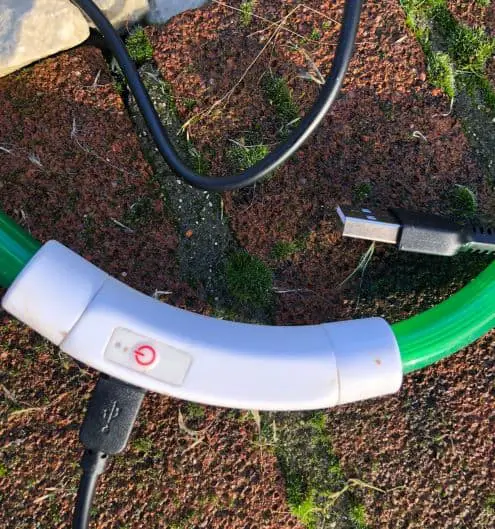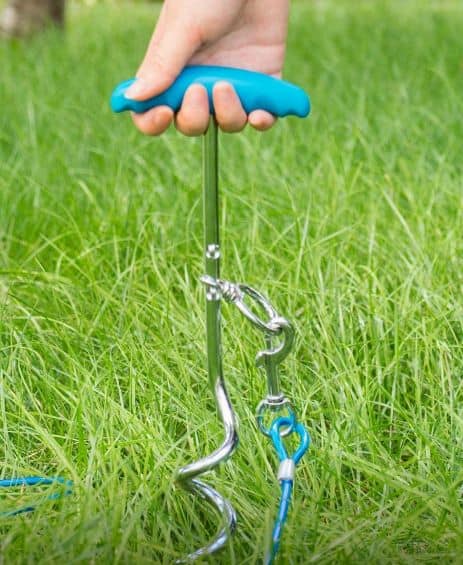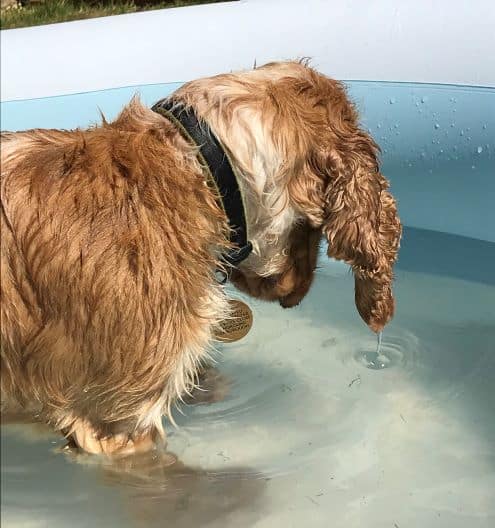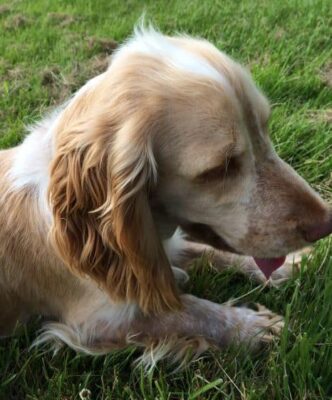This post contains affiliate links.
Camping with a dog is the same as camping with kids. You can’t just pop a dog into a car and hope for the best. You hope everything will be okay and you have all you need. Unless you are organised, you will forget something.
Here is a list of items you will need to ensure that your dog is happy and comfortable during a camping trip and make your life easier.
1 – Picking the right campsite for your dog and family
Picking a suitable campsite for yourself, your family, and your dog is an essential part of camping. You want a campsite that allows dogs, and there is plenty of area on-site or within walking distance to the site so your dog can exercise and have off-lead time.
| Pitch size | Can you cordon off your pitch to stop your dog from escaping |
| Fees | Usually, a cost of £1 – £1.50 per night |
| Designated pitches | Some campsites have set areas for people camping with their dogs |
| Type of campsite | Noisey, busy or a quiet campsite |
| Rules of campsites | Dogs must always be on their lead – but you can use an extendable dog lead, no more than 2m Need to clear up after them – use poop bags Not be left unattended. Not be classed under the Dangerous Dogs Act 1991 |
| Dog exercise areas | Camping with dogs is becoming more popular, and campsites provide more secure exercise areas. Some campsites have fenced-off tent pitches, so you do not need to worry about your dog wandering off. |
| Local attractions | Are there local attractions that will allow your dog to enter |
| Where can you exercise your dog freely | Where can your dog run off lead or long walks away from the campsite |
If you are camping for the first time and unsure how your dog will react. There are steps you can take to prepare your dog in advance for their first-ever camping trip. When we first started camping, we began preparing our dog for camping about 2 months prior.
2 – Nearest vets to your campsite
When searching for a campsite, I always check to see how near the local veterinary services are. However, there may be a veterinary practice, but it may not have a 24hrs service. The emergency surgery may be in another town, or many practices outsource night emergencies to an independent company.
If you are unsure, contact the nearest vets to confirm if they offer emergency service or speak to a staff member at the campsite.
3 – Keeping your dog safe when travelling to the campsite
Typically, it is a jigsaw puzzle trying to fit all of your gear and family members in the car when camping. Travelling in a van is easier, but it is more complicated if you are in a car. However, it makes it easier with a trailer or a roof box to give you extra space inside.
Although there is no legal legislation, the highway code states that you must secure your dog when travelling to avoid accidents.
Your dog can be secured by:
- Back seat harness
- Crate
- Boot Guard
- Boot cage or guard to avoid jumping out when you open
Rule 57 of the highway code states: “When in a vehicle make sure dogs or other animals are suitably restrained so they cannot distract you while you are driving or injure you, or themselves if you stop quickly. A seat belt harness, pet carrier, dog cage or dog guard are ways of restraining animals in cars.”
Highway code
It’s crucial to ensure that you are driving safely with your dog, as you can be fined up to £5000. Especially if the police stop you and there is concern about driving without due care and attention.
It can invalidate your car insurance if you have an accident because you are distracted by an unsecured dog in your car.
4 – Plenty of toilet stops and water for long journeys
Like us, your dog needs lots of toilet breaks to stretch its legs and have a drink and food. On average, we stop every 1 to 1 1/2 hrs.
We always carry a large bottle of water and a dog travel bowl. You can buy collapsable travel bowls, which are great for popping into your rucksack when you are out and about. However, if you have space, you can buy a no-spill bowl that you can keep filled and leave on a flat surface while driving.
If it is hot, pop some ice in your cool box and place some in your dogs’ water bowl when you stop. No-spill bowls are great for keeping inside of a tent, as they are impossible for a dog or kids to knock over.
5 – Add items to your own first aid kit for your dog
First aid kits are expensive, and having one for yourself and another for your dog is not worth buying. You will need additional items, but 90% of the items in your kit can be used on your dog.
Saline wash can be used on your dog, but not rubbing alcohol wipes for cleaning a wound. Alcohol wipes can cause vomiting or worse symptoms in a dog.
What additional items do you need to add to your first aid kit:
- Self-adhesive bandage
- Dog collar to avoid trying to lick wounds or remove bandages
- Paw boot cover
- Muzzle or slip lead
- Rectile thermometer and lubricant
- Hydralyte and Pedialyte liquid to rehydrate your dog – confirm with your vet
- Antibiotic medication – confirm with your vets
- Antihistamine medication – confirm with your vet
- Dog wipes
- Tick removal tweezers
- Mouthguard for CPR
Never give your dog human medication
6 – Keep spare medication for emergencies
If your dog is on any medication, avoid losing track if they have had it. Split down into a daily tablet box. It helps you to keep track. It’s so easy to become distracted and forget because you are out of the routine away from home.
I always kept Gizmos medication in the tablet holders, but I always carried a spare in my rucksack. If we were out longer during the day than expected, he could still have his heart medication on time, no matter where we were.
7 – Emergency contact numbers and microchipping your dog
All dogs have to be microchipped by law in the UK. Check your contact details are correct before your camping trip. If your dog is found, you can be easily contacted.
Have a dog tag with your contact details and another label saying they are microchipped. If your dog has any medical issues add this information, especially if your dog requires daily medication.
Some microchipped companies will allow you to add another emergency contact if they cannot get hold of you.
8 – Find your dog easily with a flashing light on their collar

It is so easy for your dog to wander off or curl up in a quiet corner, and you panic because you cannot find them. A flashing or static light attached to a dog collar or harness will help find your dog quickly. However, the flashing light can be annoying but switched off when not used. However, the lights run out of battery fast or break easily. So always keep a spare.
For everyday usage, we use a rechargeable LED collar. If you don’t want your dog to wear an additional collar, secure it onto the harness or wrap it around the lead. Your dog does not need to wear the collar during the day, so you can recharge if necessary. Either use EHU or recharge whilst travelling in your car during the day.
We use the AREVERA LED Dog collar from Amazon. It is a solid waterproof collar, straightforward to use, with a simple push-button on/off. For less than £10. It is not an elaborate dog collar. You only use it part of the year, so I don’t think there is any reason to spend a fortune. We have used this for several years, and my sister has the same collar for her dog.
9 – Chews, treats and toys for your dog
Your dog will most probably be exhausted after a day of activities. However, they always seem to get a second burst of energy when you want to relax. Mentally stimulating your dog will keep them occupied and help them relax, and tire them out.
Simply crumble and scatter dog treats on the ground in your pitch area. Your dog will enjoy it; however, don’t scatter too much as they become bored, and you don’t want to attract unwanted wildlife.
If you have a high-energy dog, they can become very bored and destructive. Having plenty of toys and chews to keep them busy will save your tent. A bored dog that loves to chew can be an expensive holiday.
10 – Ground stakes: Keep your dog safe

Ground stakes are spiral and screwed into the ground. They have a cable attached that connects to a collar or harness. Depending on the size of your dog will depend on the type to stake you buy and the cable strength.
Dog Stakes are handy items to keep in your car. The dog stakes can be used at the park or in your back garden. Not just for camping. However, if the ground is very hard, they are difficult to screw in or pull out quickly if the soil is too wet.
Camping during hot weather, the ground will be solid, and the stake can be difficult to twist into the ground.
The metal handle stakes are difficult to grip if the ground is solid. You will need a towel or a soft covering to avoid hurting your hands.
When buying a ground stake for your dog, buy a stake that has a plastic handle. We have used the Petphabt stake from Amazon, which has a good solid grip handle.
11 – Secure your pitch with a windbreaker or fencing
You can cordon off your pitch several ways, giving your dog freedom to roam. Windbreakers or fencing can be placed around your pitch, up to your tent. It is tough to leave the pitch area without moving stakes by placing windbreakers up to the edge of your tent.
The fencing can be a deconstructed cage with stakes that thread through each end of the fencing panel. The stakes are the height of the fence pushed down into the ground. Or the fencing can be used to create a cage for your dog.
Windbreakers vs fencing for your dog
| Type of fencing/windbreaker | Pros | Cons |
|---|---|---|
| Beach windbreakers | Cheaper £6.99 – £15.99 Available in different lengths 4 – 10 poles | Wooden stakes crack Not very sturdy Easy to knock over if you have a strong dog Bulky for travelling Restrict access to and from your tent area |
| Camping windbreakers | Stabilised by using guy ropes and pegs Either inflatable or polyester fabric Collapsable poled for packing. Easy for transporting Windows so you are not shut off completely. Average height 1.4m | Expensive – £35 – £60 poled windbreaker The windbreaker needs to be pitched correctly. Your dog can push through or knock over easily. It can be awkward to pitch by yourself. Restrict access to your tent area |
| Fencing | Depending on height/design has a gate for easy access. Solid and not easy to knock over Pegs to stake to the ground It can be fencing or a cage | Expensive – £40 – “110 Heavy and bulky for transporting Fencing around your pitch restricts access to and from your pitch area. |
12 – Cooling your dog: Paddling pool or cool mat

A dog can be kept cool with a paddling pool or a cool mat. If you don’t have access to water, a cool pad is the best option, plus they are not as messy as a paddling pool.
Coolmats are designed to cool off and regulate your dog’s body temperature. They have a chemical gel inside that activates the chemicals inside when your dog lays on the pad. The mat absorbs the heat from your dog’s body. You don’t need electricity or place it in a freezer or fridge to cool, which is excellent for camping. It is ideal for travelling in a car on a hot day as it will keep your dog cool.
However, if you have a dog that loves to chew, I would not recommend a cool pad, even though the chemical is non-toxic. Prices range from £15.99 – £35.99, depending on size.
If you have access to water, why not let your dog cool off and play in a small paddling pool. Paddling pools are cheaper than cooling mats and can be purchased from local stores for about £3, depending on the size you need. If it gets damaged, you have no worries when you throw them away. Small child paddling pools are cheap to buy and easy to transport. Small paddling pools can be inflated easily, depending on the type of air pump you have, whether an electrical or battery-operated pump.
We use our dogs’ paddling pool whilst camping and in our back garden on hot days.
13 – Use a tarp instead of a dog shelter: Allow airflow and not stifling like a tent
Dogs do not cope with heat the same as we do. They pant shallowly and breathe through their noses, releasing heat. Their paws can also disperse heat.
Creating a shaded area for your dog to rest and cool down during the warmer temperatures is essential to avoid potential heatstroke.
There are dog shades available, which are like mini-open tents. However, I have not found these useful. There is a restriction of airflow due to only a front entrance. It can be unbearable if you think about how hot your tent gets during the day, even with open doors.
We have used a tarp in the past, as it offers shade for everybody. A tarp allows sufficient airflow, reducing the stuffiness of an enclosed dog shelter. Plus, dogs want to be with you and your family.
14 – Sunscreen will stop sunburn on pale-skinned dogs
If you have a pale-skinned or short-haired dog, they can quickly burn in direct sun. You can’t use human sunscreens; it is toxic, as they will lick themselves. Specialised formulated dog sunscreen does not contain zinc oxide or para-aminobenzoic acid (PARA). Your furry friend will not be hurt if they ingest, whether a cat or dog.
I recommend speaking to your local vets before buying any products offline. In the past, I have used Petkin SPF 15 Doggy Sunscreen from VioVet, which is a wipe instead of a cream. It is easier and cleaner to use. You can tuck away in your rucksack easily and avoid leaks. They also have a stick suncream, which I have found hard to apply.
15 – Don’t forget your dogs’ food and water
It’s easy to forget, and I have in the past. I prefer to take dry foods or sachet foods rather than tinned dog foods. There is nothing worse than having a half-eaten can of dog food. It smells and draws flies to your area.
I measure out the food and place it in separate bags per helping, so I do not have to worry about taking a measuring jug with us. I will also take a couple of extra helpings for an emergency.
We can grab a bag and feed our dog, Gizmo. It is so easy, and there is no worry about overfeeding.
Have several bowls of fresh water available inside and outside your tent to hydrate your dog, especially if it is hot. On an average day, for every 1 lb bodyweight of your dog, they should drink at least 1oz of water.
Keeping water cool is not always possible, especially if your cool box is not very big. Buy some ice cube bags and store them in a plastic bag with your name in the campsite’s freezer. During the day, you can top their drinking bowl up with ice cubes to help cool down.
16 – Take your dog’s favourite blanket

Your dog may be an experienced camper, but like us, they want something that they love and that makes them feel at home. Taking their favourite blanket will not only help to keep them warm, but it will also help to settle them. Especially if the campsite is noisy or there is strong wind or rain.
Gizmo had his favourite fleece blanket and cuddly toy. Where ever we went, we would have to take these for him. It settled him during the evenings and at bedtime.
17 – How to keep your dog snug and cosy at night
If you have a small dog, it is easier to keep them warm as they will probably curl up in your sleeping bag with you if you have room. However, for larger dogs, it is more challenging. They can’t curl up in your sleeping bag with you, although it is possible if you have a quilt. Still, it may be a bit cramped if you have limited space.
There are several ways you can help to keep your dog warm at night.
| Ways to keep your dog warm | Pros | Cons |
|---|---|---|
| Dog travel crate | Soft collapsible crates are ideal for transporting. It can be folded when not in use for storage or transporting Solid cages are easy to clean. Different sizes depending on your dog. | Solid cages Not ideal for transporting Expensive – £35.99 – £89.99 depending on the size |
| Raised dog bed | Your dog can sleep off the ground. Ideal if your dog has arthritis or joining issues Some have covers to provide shade. It can be used outside. It can be disassembled for transport. It can be used in your home. | It can be expensive depending on the type your buy £22 – £84 You will need to buy additional blankets/covers to help keep the cold at bay. |
| R valued 3/4 sleeping mat | Expensive to buy Self-inflatable Wipe clean easily Easy for transporting It keeps the cold from seeping through to your dog | If your dog is a chewer, not ideal Not worth buying if you have a small dog It can be expensive depending on what you buy. |
| Enclosed cat bed | Ideal for small dogs It can condense down easily for travelling Enclosed fur shell, ideal for small dogs Washable | For small dogs or puppies only. It can be expensive – the average price £25 – £30. Buy from a local store, and they can be £10 approximately to buy Easy to chew Hard to get fur off if your dog is malting |
| Sleep bag for cats and dogs | Ideal for small dogs and puppies Can sleep inside and on top Ideal for transporting Furr lined, making it cosy. Washable | Expensive – £20 – £30 Not suitable for large dogs Hard to get fur off if your dog is malting |
18 – Keeping your dog clean
You will need a way to clean your dog while you are away. Especially if they have sandy or muddy paws, you want to keep your tent clean. However, removing any mud from their paws is essential to reduce potential soreness between the pads. Plus, if they lick their paws, they can ingest the larva from worms.
If your dog finds fox poo, which is the worst smell ever. You need to clean your dog efficiently and quickly.
It is not possible to take your dog into a shower block. You will need to clean your dog outside. I have not found a campsite that allows you to clean your dog inside a shower room or supply facilities for them.
Best way to keep your dog clean when camping: Pros and cons
| Type of dog cleaner | Pros | Con | Cost |
|---|---|---|---|
| Camping shower | It can be used as a shower for you and to clean your dog Saving money buying a multi-function shower Good water pressure Foot pump and rechargeable battery pump Direct spray easy Solar heated and will keep water warm. Automatic pressure when required | Not really for cleaning your dog Difficult to carry as it has a small handle Expensive if you just want to clean your dog Rechargeable battery pump expensive compared to foot pump model | £37 – £49.99 |
| Mud Daddy Portable pet shower | The brush attached which is ideal for cleaning your dog Can keep in your car boot It can be used to clean wellies or dirty shoes. Water stays warm for about 2-3 hrs. You need to heat the water first | Needs to be pressurised to work Have to repressurise often, so challenging to use Bulky Expensive | £44 – £50 |
| Paddling pool or bowl of water | Cheap Use a collapsable bowl | Messy Cleaning your dog in dirty water If you use dog shampoo, it is difficult to remove bubbles | under £10 |
| Dog paw cleaner | Cleans one paw at a time The bristle at the top removes dirt. | It takes time for you to get used to using it. Can scare them Easier to use a small jar It can be uncomfortable for your dog. Time-consuming | £9 – £15 |
19 – Towels to dry your dog: Lightweight and easy to dry
Micro towels are lightweight and great for drying off your dog. Prices range from £6.00 to 19.99. Although they are expensive, they absorb water quickly and dry quickly. They fold easily and are ideal for keeping in your rucksack or tucked in the boot of your car so you can quickly dry your dog.
Compared to regular everyday towels, they will not take a whole day to dry, and there are no worries about them falling off a tree branch of a camping drying rack because the pegs are not strong enough.
We use a micro towel when camping for our dog and us. We have different colours so we do not get mixed up.
20 – Foil blanket for emergencies
We always have an emergency foil blanket with us wherever we travel. If you and your dog are stranded in the pouring rain with insufficient shelter, foil blankets are a quick and easy way to warm your dog. If it is extra cold at night, you can lay over your dog, and he will quickly warm up.
Foil blankets are designed to reduce heat loss. They are not given an R-value like sleeping bags, so you cannot buy different grades. They have a life span of no more than 2 years, as they will degrade in time. However, the life span does depend on how they are maintained.
21 – Odds and ends: Coats, whistle, poo bags
As well as the main essentials, you will need a few extra items that can easily be forgotten.
- Poo bags
- Extendable lead
- Spare lead
- Whistle or clicker for your dog
- Warm waterproof coat
- Dog shampoo
- Dog harness
- Grooming brush
- Collapsible bowls for easy carrying whilst out for the day
- Additional dog collar tags with contact details
- Notebook with the history of any medical issues and vet contact details
Key takeaways
- Find a dog friend campsite
- Check local areas so your dog can let off steam
- Create a checklist
- Confirm local vets near the campsite for emergencies
- Be prepared for any event


